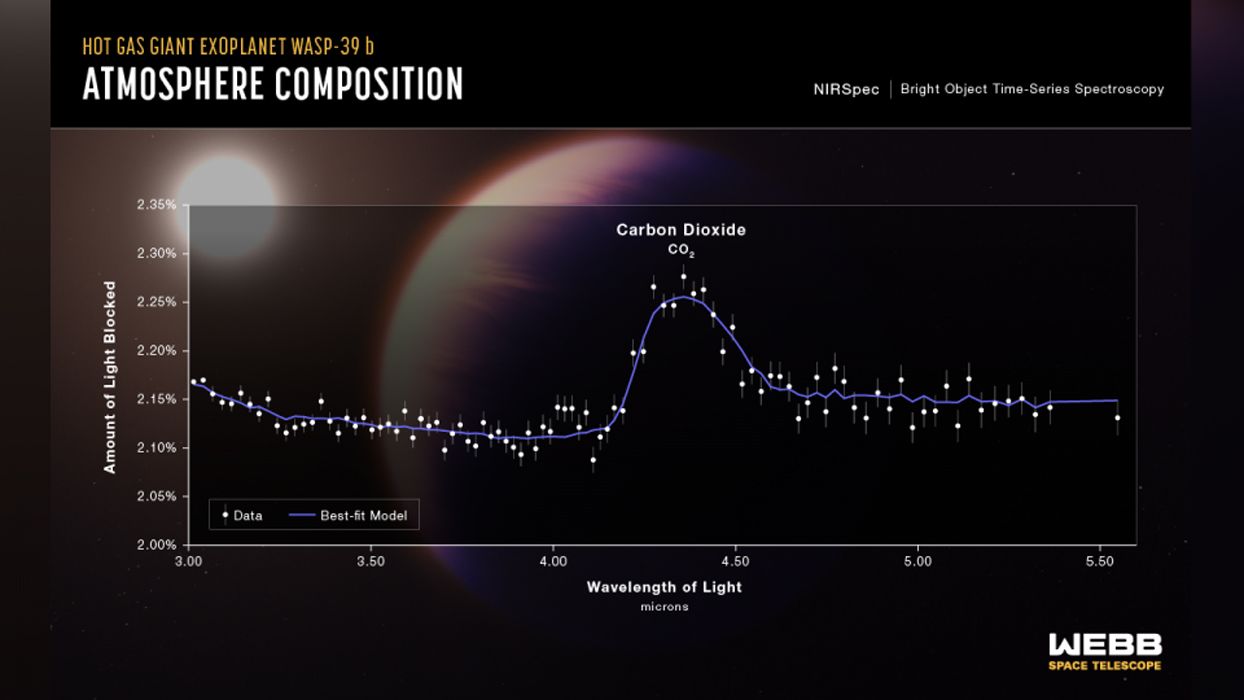Using JWST’s spectrograph, researchers have measured a distant exoplanet’s atmospheric composition and found carbon dioxide for the first time

JWST can do more than just take pretty — and sometimes blobby — images. Using its spectrograph, researchers can measure the composition of distant objects. In a first-of-its-kind measurement, JWST revealed carbon dioxide in the atmosphere of the exoplanet WASP-39 b.
The results will appear in a forthcoming paper in Nature led by Eva Maria Ahrer.
The planet in question is WASP-39 b, a gas giant discovered back in 2011 orbiting a star similar to our own Sun. The planet’s mass is similar to that of Saturn, but it’s orbiting very close in to the star every four days, which means the atmosphere is extremely hot at 1,400 degrees Celsius. And don’t get too excited about where this star system is, either, because it’s 700 light years away. This is not a “let’s find life here” kind of place.
And to avoid confusion, this is not the same planet NASA earlier released spectrographic results for during the press conference in July. That was WASP-96b, and its atmosphere was found to have lots of water.
But the methods are the same. WASP-39 b appears to pass directly in front of that star during what is called a planetary transit. JWST observed the atmosphere of the exoplanet by looking at its star’s light passing through the atmosphere during a transit and collected a transit spectrum of the star’s light as it passes through the atmosphere of the exoplanet. Different atoms and molecules absorb and emit light in specific and known waves, and by looking for dark bands and bright strips in a spread-out rainbow of the star plus the planet’s light, researchers can tease out the composition.
Using the known wavelengths cataloged for a variety of molecules, scientists then compared the data collected and determined the composition of the atmosphere. In the case of WASP-39 b, they found a very clear signal of carbon dioxide.
Co-author Michael Line has one of the best press release quotes ever, saying: I felt like a kid in a candy store when I first saw this spectrum. The fact that we can see unambiguous bumps and wiggles — point to them and say, ‘Hey, that’s carbon dioxide, hey, that’s water vapor, whoa, here’s this other bump and I don’t know what it is!’ — suggests enormous potential for discovery in the worlds beyond our solar system. It truly is a game changer.
As we learn more about each exoplanet’s atmosphere, we also learn more about how that planet originated and evolved. Line goes on to explain: Carbon dioxide molecules are sensitive tracers of the story of planet formation. By measuring this carbon dioxide feature, we can determine how much solid (carbon and oxygen-rich ices) versus how much gaseous (hydrogen and helium) material was used to form this gas giant planet.
This… this is the science we were waiting for from JWST, and this is only the beginning. The observations are a part of the Early Release Science program which is providing the planetary science community with “robust JWST data as soon as possible.”
And we look forward to more of these early results.
More Information
ASU press release
“Identification of carbon dioxide in an exoplanet atmosphere,” Eva-Maria Ahrer et al., to be published in Nature (preprint)
This story was written for the Daily Space podcast/YouTube series. Want more news from myself, Dr. Pamela Gay, and Erik Madaus? Check out DailySpace.org.
This article was originally published at medium.com.





